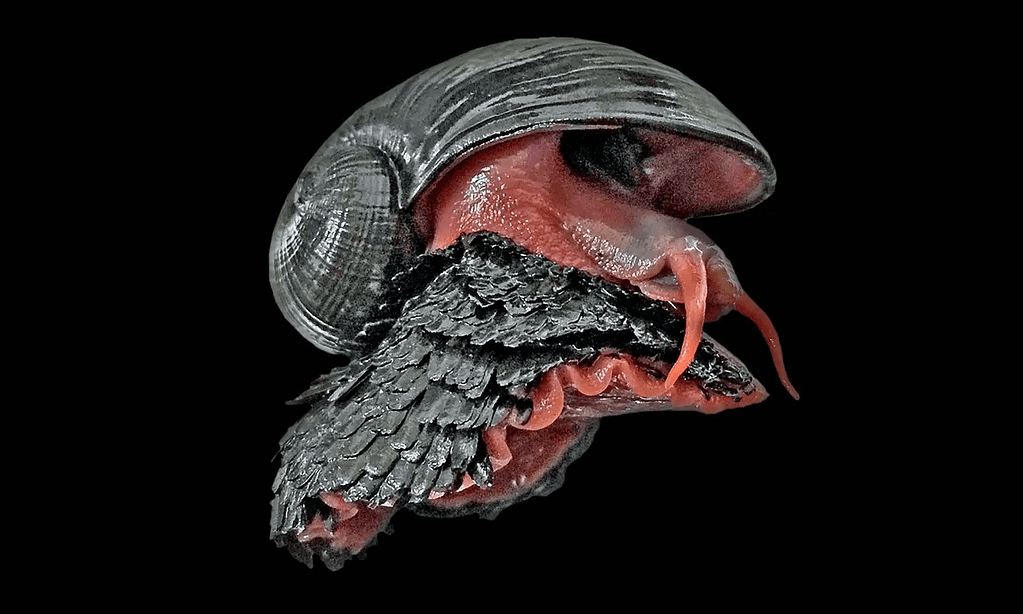
[ad_1]
Amazing animal Series
A golden snail with a foot made of iron scales looks like a sci-fi creature. But in some remote parts of the Indian Ocean, these snails are very real.
“It looks like an armored knight crawling around on the deep sea floor,” says Julia Sigwart, a biologist at the Frankfurt research institute Senckenberg and one of the few who has seen a scaled foot snail (Chrysomallon squamiferum), which is also known to be a sea pangolin.
The habitat of the snails is extreme. They live several miles below the ocean’s surface in scorching hydrothermal vents bathed in toxic chemicals that can reach temperatures in excess of 300 °C (572 °F).
The snails’ entire body and lifestyle revolves around bacteria that grow in a special sac in their throats, which convert chemicals pouring out of the vents into energy, thus providing all of the snails’ food.
To keep their microbes well fed, scalefoot snails evolved huge gills to take in oxygen and chemicals from seawater and then release them through their bloodstream and an enormously spacious heart. A human heart of appropriate proportions would be as big as our head.

When you say a species is on the verge of extinction, everyone understands Julia Sigwart, biologist
In 2019, scientists found that the scales on the snails’ base are not designed to protect against predatory attacks, but to ward off a toxic threat that comes from within. The bacteria hiding in a scalefoot snail’s throat release sulfur as a waste product that is deadly to snails (it’s a common active ingredient in snail and snail-killing pellets).
The inner structure of their scales acts like tiny exhaust pipes, drawing the dangerous sulfur from the snail’s soft tissue and depositing it outside as a harmless iron-based compound.
Although they have evolved many strange adaptations to survive on vents, scale snails have not relied on humans to show an interest in their habitat. All three of the sites they live in — an area less than 0.025 square kilometers (0.01 sq mi) that together would fit in St. Peter’s Square in Vatican City — are potential targets for deep-sea mining.
Mining companies are after gold, silver and other precious metals or rare metals that are deposited in the rocky walls of the black smoker’s chimneys. If their tiny habitats are damaged or destroyed, the scaly foot snails would soon be gone.
Because of this, Sigwart and her team set out to assess the status of these rare animals, eventually having the scale-foot snail listed as an endangered species on the International Union for Conservation of Nature Red List.
“It’s an incredibly powerful communication tool,” she says. “When you say a species is in danger of extinction, everyone in the world understands it.”
The scalefoot snail was the first species in the world to be listed as threatened due to deep-sea mining, but there are now many deep-sea molluscs that experts have assessed and placed on the world’s endangered species list.
Of 184 endemic species living only on vents, from giant clams to a fuzzy snail named after Joe Strummer from The Clash, only 25 are considered non-extinct.
These species remain relatively safe, Sigwart explains, because they live in vent fields where future deep-sea mining development is specifically prohibited. These include marine protected areas in Canada’s territorial waters and around the Azores.
More Similar Article from The Mahathian Post
Most other species live near hydrothermal vents that lie outside territorial limits and are therefore less protected and more open to mining exploration.
“These are Red List assessments that reflect the status and risk to the entire species and its potential to actually go extinct and lose us entirely,” says Sigwart, “and nobody wants that.”
For Sigwart, these unusual mollusks brilliantly illustrate that evolution is all about being good enough to get by. “It shows us the strange and tortuous paths life can take to adapt and survive,” she says.
Post Views:
3
[ad_2]
Source link